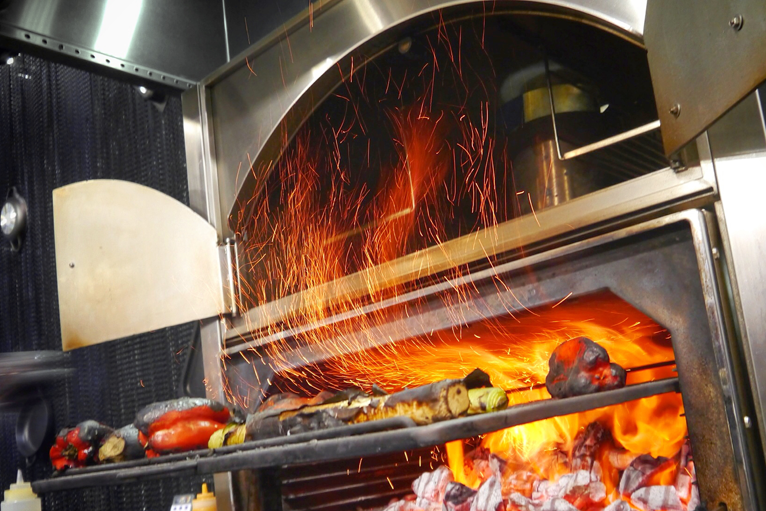Solid fuel cooking is defined by the International Mechanical Code as “any bulk material such as hardwood, mesquite, charcoal or briquettes that is combusted to produce heat for cooking operations.” This type of cooking is typically used to cook proteins (such as steaks, hamburgers, and chicken). The types of effluent emitted from solid fuel applications include particulate matter (PM) and grease vapor. Additionally, the combustion of wood generates particulate matter, ash, embers, and smoke.
As noted in the International Mechanical Code the key to the definition of solid fuel is that it is combusted to produce heat for cooking. There is also solid fuel that is combusted to impart flavor (not heat) to the food being cooked. You should verify which appliance you have to confirm the code requirements you must follow.
The category of solid fuel cooking falls under “extra heavy-duty”. Unlike a typical type I hood, which can be combined on the same duct system within a hazard area, solid fuel cooking must have its own duct system. It can not be combined with any other duct system. See section 507.2.2 of the International Mechanical Code for further details.
Exhaust Hood Selection for Solid Fuel Cooking Ventilation
The recommended best practice for this application starts with the selection of the exhaust hood. First, we recommend that a continuous mist exhaust hood with high-efficiency grease extraction be used for solid fuel applications. High-efficiency grease filters with spark arrestors provide grease extraction as well as some level of ember and ash protection as mandated by code. Ash and embers that make it past the primary grease extractors then encounter continuous mist spray. The mist spray serves the purpose of reducing the sparks, embers, and ash that reach that section of the hood as well as reducing the temperature of the exhaust air stream which reduces the risk of duct fires. The quantity of exhaust is greater than mixed lines because of the intensity of the heat and effluent generated. Attention should be made in determining the appropriate exhaust and make-up levels.
The listing for the exhaust hood is required to follow U.L. 710 and be rated for “extra heavy-duty” or 700 degrees (solid fuel) and carry the label for the same.
After the effluent leaves the hood it travels down the duct until it reaches its terminal point. A heavy-duty exhaust fan with the updated U.L. 705 standard should be used. Since the exhaust fan will see high temperatures, the motor should be isolated. In addition, the old UL762 has been merged into U.L. 705 (ULC S645) Standard for Power Roof Ventilators for Commercial and Institutional Kitchen Exhaust systems.
A pollution control unit (PCU) may take the place of an exhaust fan if the final grease, smoke, and odor removal are required or if the local municipal code requires it. The two types of PCU’s are ones that incorporate electrostatic precipitators (ESP’s) or units that utilize dry filters to remove the grease. It is recommended that with solid fuel cooking applications, double-pass (two-stage) ESP’s with nightly washdown systems be used because they are cleaned of grease nightly which reduces the fire risk compared to a dry filter PCU in the event that sparks and embers do reach the PCU. Furthermore, because of the high levels of grease produced with this cooking process dry filter units will load relatively quickly with grease which can lead to higher maintenance costs and maybe an additional fuel in the case of duct fires.
For smoke elimination in this application, it is recommended a HEPA filter be used which has a minimum efficiency of 99.97% at 0.3 microns. For optimal odor reduction, it is recommended the use of UV lamps in combination with 2-stage carbon panels consisting of 2-inch-thick carbon filters.
A solid fuel cooking exhaust system requires ongoing and regular maintenance. The byproducts from solid fuel cooking will coat the exhaust duct and load the filters of the pollution control system (if so equipped.) If you are contemplating such a system, make sure you take into account ongoing maintenance costs. In addition, the ductwork should be inspected regularly to prevent a build-up of combustible materials.
Fire safety is the main concern for commercial cooking operations and it is even more acute for solid fuel. If properly maintained, the risk can be mitigated while delivering mouth-watering steaks and barbeque!
Our recommended next article would be: Specifying Commercial Kitchen Exhaust Hoods(Opens in a new browser tab)
Subscribe to kitchenventilation.com
Stay up to date by subscribing to Halton’s Commercial Kitchen Ventilation Blogs by entering your email address to subscribe and Halton will provide you with the latest information on commercial kitchen exhaust hoods, pollution control units, air handling, and safety systems. You will receive notifications of new posts by email.

